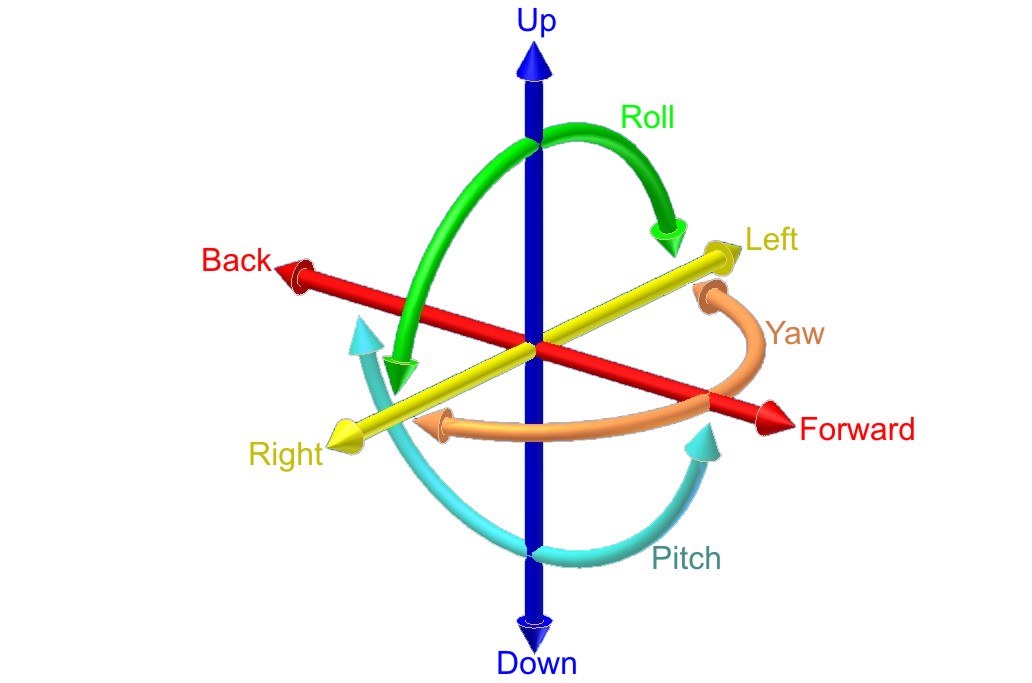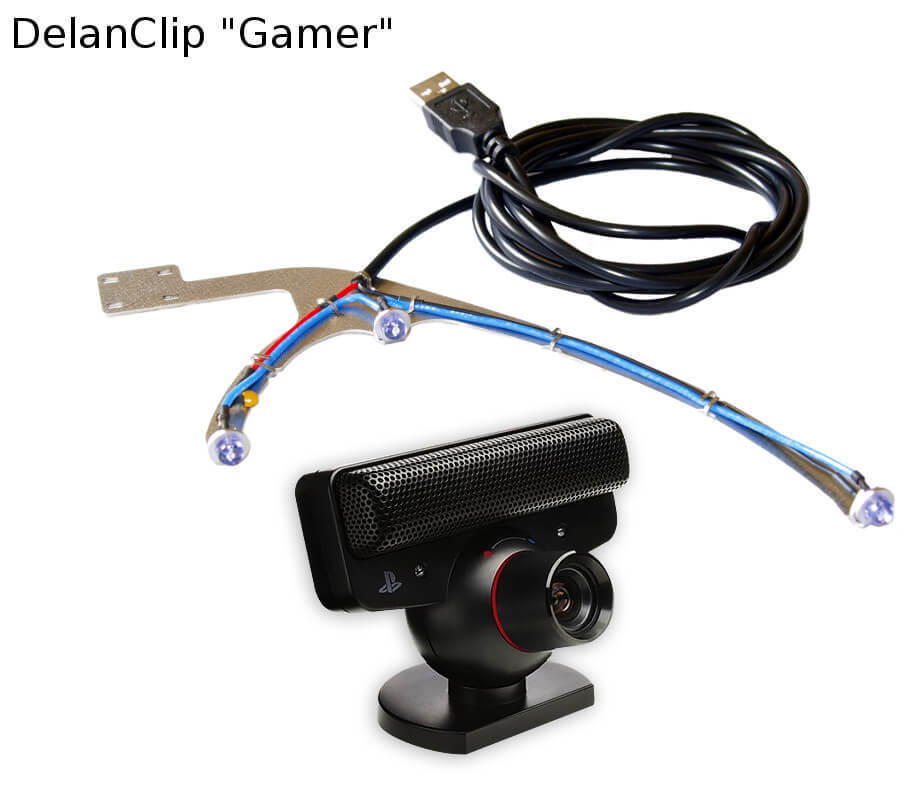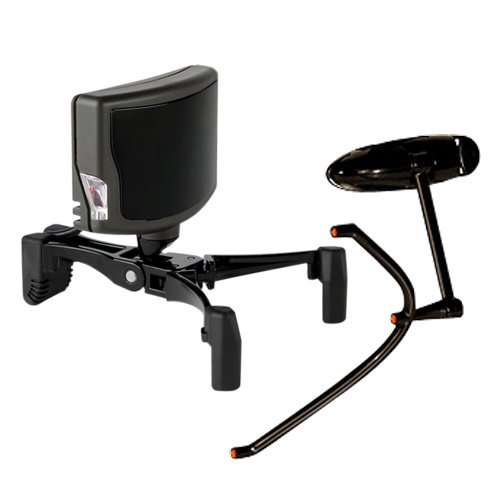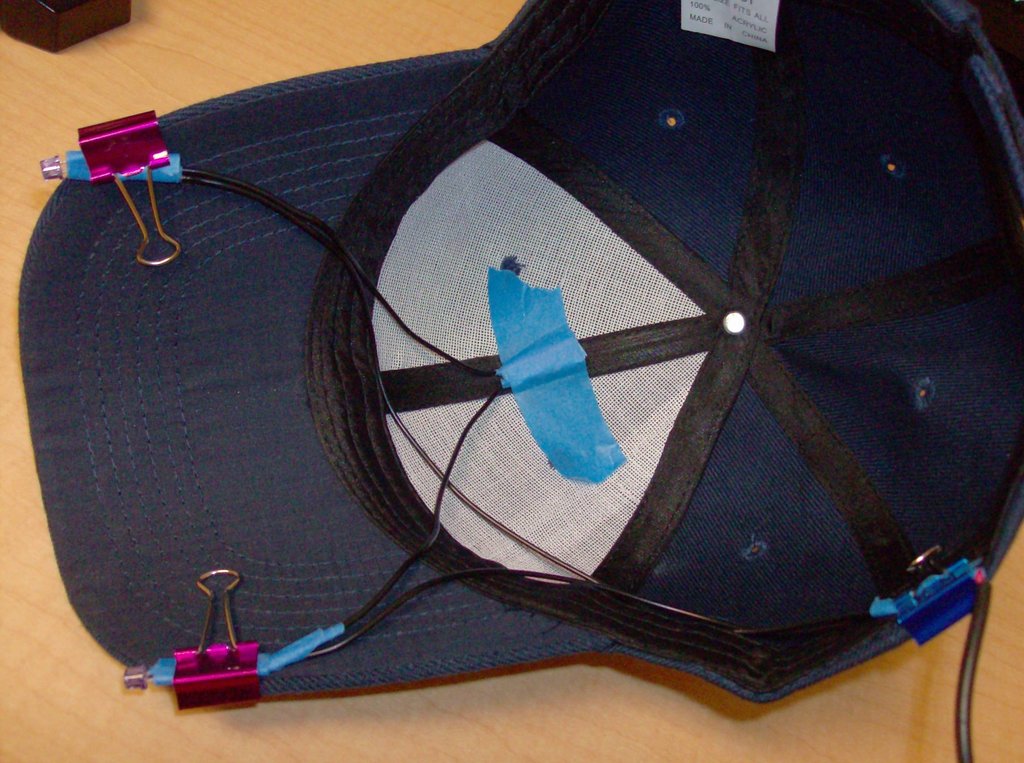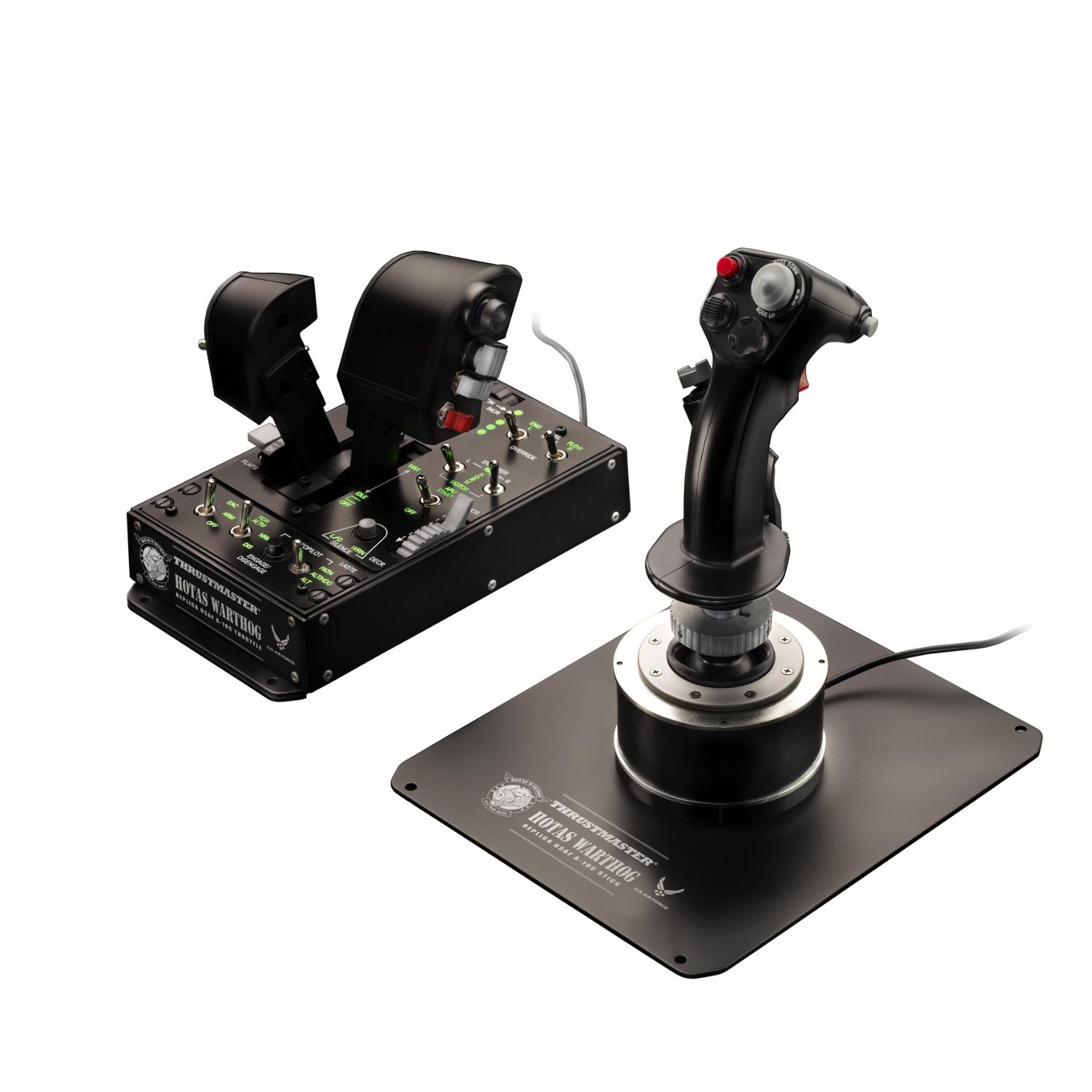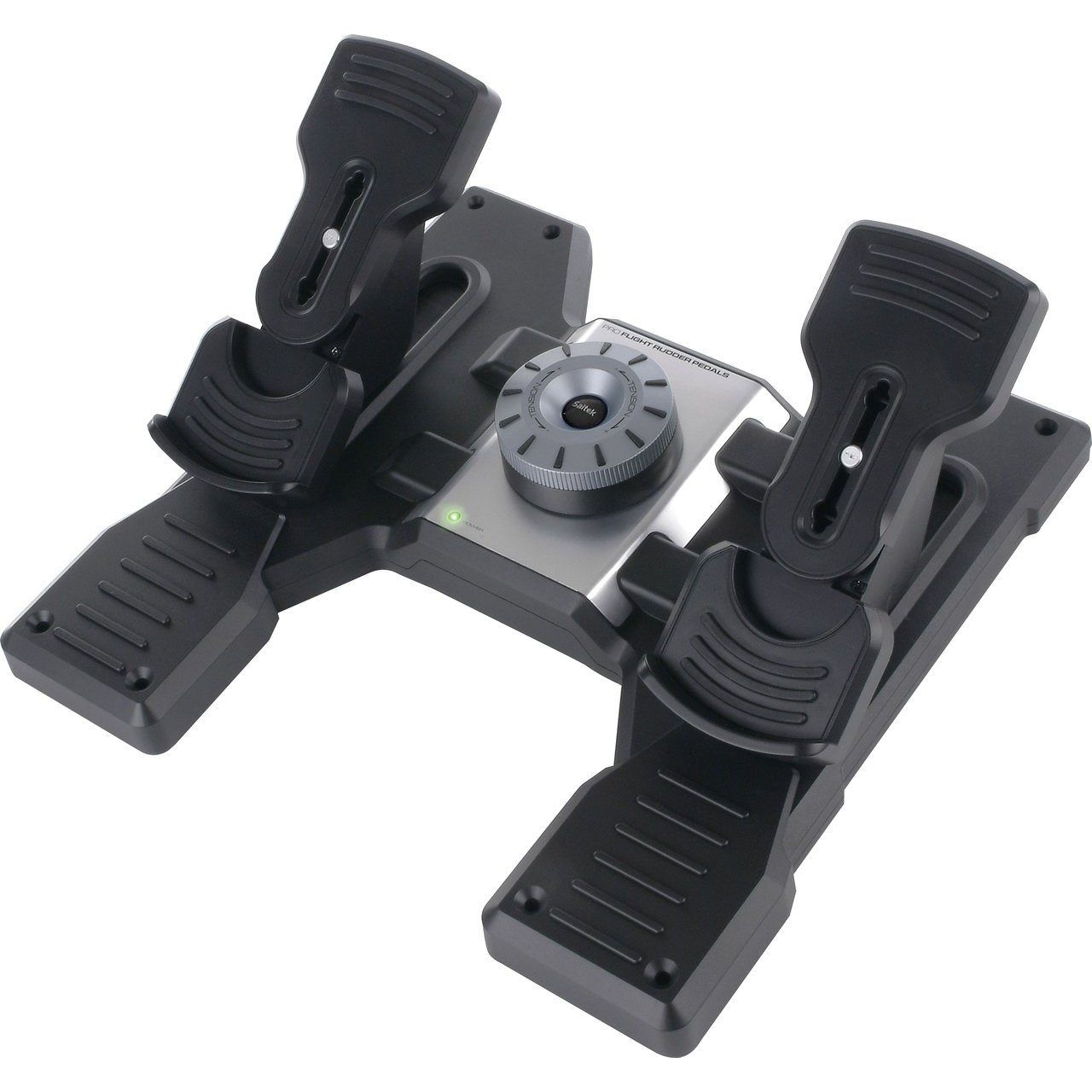Difference between revisions of "Peripherals Guide"
(→Thrustmaster T.16000M FCS Hotas: fixed amazon link) |
(Shown the headtracking section some love) |
||
| Line 10: | Line 10: | ||
__TOC__ | __TOC__ | ||
| − | ==Head Trackers== | + | ==Head Trackers: Short intro== |
| − | Headtrackers are optional however after using them many players would rather fly with a crap stick than give theirs up. | + | |
| + | [[File:6DOF en.jpg|thumb|right]] | ||
| + | |||
| + | Headtrackers are optional however after using them many players swear by them and would rather fly with a crap stick than give theirs up, thanks to the added benefit of having the '''ability to look around simply by moving your head'''. | ||
| + | |||
| + | Most headtrackers work by detecting a pattern of IR lights, which are then converted into the various head movements. We typically classify these movements as 6-DOF (Degrees of Freedom), i.e. the six axis in which you can move your head (registered by the headtracker): X- (horizontal, side to side), Y- (vertical, up and down), Z- (zoom, forwards and backwards) movement, as well as X, Y, Z roll (i.e. tilting or twisting your head). | ||
| + | |||
| + | This movement is received by what is for all intents and purposes a (modified) webcam, typically placed on top of your screen. This webcam is following (tracking) a pattern of InfraRed (IR) lights and using these to decipher what your head is doing to represent this head movement in-game (albeit amplified, so you can still look at your screen). For this the webcam needs to have its infrared filter removed: infrared is invisible to the human eye and most cameras use a filter to block it out (as heatsources such as the sun radiate infrared waves and would thus overexpose the camera with light). | ||
| + | |||
| + | Once the filter is removed you can now follow a series of IR lights (placed in a pattern) to track the head movement: to still be able to look at your screen the actual head movement is amplified in the game (with your own set curves, in your headtracking software of choice). It is worth noting that the actual resolution and precision comes mainly from the camera (although the software also plays a role) and rarely has to do with the pattern of IR lights attached to your headset / hat (head). | ||
| + | |||
| + | ---- | ||
| + | |||
| + | |||
| + | === Headtracking hardware === | ||
| + | |||
| + | Below we have listed the 3 premiere headtracking solutions that people use: | ||
| + | |||
| + | <gallery widths=300px heights=300px> | ||
| + | File:Delanclip.jpg|none|alt=Alt text|DelanClip | ||
| + | File:Trackir.jpg|thumb|TrackIR by Natural Point | ||
| + | File:Freetrack hat.jpg|thumb|A Freetrack IR hat build | ||
| + | </gallery> | ||
| + | |||
| + | |||
| + | ====Delanclip==== | ||
| + | |||
| + | [https://https://delanengineering.com/ Delanclip] is a low cost solution that uses 3 IR LEDs attached to a metal bracket that attaches to your headset (instead of Trackhat which as the name implies attaches to a hat or cap). It rivals the performance provided by TrackIR itself (being just shy in tracking quality, [https://delanengineering.com/manual/facetracknoir/ although a bit more difficult to setup but with an excellent guide]), with no discernable performance drawback in bright light environments. For the price (costs around 40 EUR) vs. performance it offers it beats out TrackIR, and as such offers a good head tracking beginner set. Delanclip also manufactures a wireless clip that removes the need to be anchored to the PC via an USB wire providing power, supposedly delivering up to 8 hours of head tracking on a battery charge. | ||
| + | |||
| + | <div class="btn btn-primary">[https://delanengineering.com/products/ Delanclip Overview]</div> (approximately 40 EUR) | ||
| + | |||
| + | |||
| + | ====TrackIR (by Natural Point)==== | ||
| + | |||
| + | TrackIR is a commercial solution by [https://www.amazon.com/TrackIr-Optical-Tracking-System-Bundle/dp/B00KQPETHO/ref=sr_1_2?ie=UTF8&qid=1547843565&sr=8-2&keywords=trackir+5 Natural Point Inc]. It is the most costly of all the head tracking options but is also quite simple to install and has a large (the largest) selection of games that natively support it, thanks to being the most well established head tracking solution on the market. | ||
| + | |||
| + | TrackIR is also a great option because it has a processor built in to the tracking unit, which means that all data processing and head movement translation calculating is done on the device itself: this means there is no performance hit on your system as this data is streamed into the TrackIR software. Other systems such as Delanclip and Trackhat instead calculate these values on the PC itself via their software, which means there is a (minor) performance hit (somewhere around 0 ~ 5%) as the system has to allocate resources to calculate these values. | ||
| + | |||
| + | <div class="btn btn-primary">[https://www.amazon.com/gp/product/B0029M6VKA/ref=as_li_tl?ie=UTF8&camp=1789&creative=9325&creativeASIN=B0029M6VKA&linkCode=as2&tag=hoggitworld-20&linkId=7780c93e19219802aaf7bb10d8795a77 Get Prices on a trackIR v5]</div> (Generally speaking they run around $120 - $150) | ||
| + | |||
| + | |||
| + | ====TrackHat==== | ||
| − | |||
[https://trackhat.org TrackHat] is a middle ground option between DIY solutions such as FreeTrack, and the premium head tracking such as TrackIR. TrackHat utilises a bespoke version of OpenTrack and 3D printed clips along with pre-configured PS3 Eye cameras to provide exceptional tracking for the price (around £35 GBP). While not as good as TrackIR (TrackHat suffers a bit when you have a bright background) it certainly has more bang for buck and is a perfect starter head tracking solution. | [https://trackhat.org TrackHat] is a middle ground option between DIY solutions such as FreeTrack, and the premium head tracking such as TrackIR. TrackHat utilises a bespoke version of OpenTrack and 3D printed clips along with pre-configured PS3 Eye cameras to provide exceptional tracking for the price (around £35 GBP). While not as good as TrackIR (TrackHat suffers a bit when you have a bright background) it certainly has more bang for buck and is a perfect starter head tracking solution. | ||
<div class="btn btn-primary">[https://trackhat.org/shop/ Get Prices on TrackHat]</div> (around $40 for everything you need) | <div class="btn btn-primary">[https://trackhat.org/shop/ Get Prices on TrackHat]</div> (around $40 for everything you need) | ||
| − | === | + | ---- |
| − | [ | + | |
| + | ===Headtracking software=== | ||
| + | |||
| + | <br /> | ||
| + | |||
| + | ====FaceTrackNOIR==== | ||
| + | [http://facetracknoir.sourceforge.net/ FaceTrackNOIR] is an open source software solution using off the shelf hardware. But instead of tracking a cap / headset with 3 known points it uses facial recognition to follow the players face, thus allowing it to work standalone (in theory). This method has the lowest cost of entry (as you only need a basic webcam), however it is the least accurate and some users have issues getting it to work. Your mileage may vary. | ||
| − | |||
| − | === | + | ====FaceTrackNOIR PointTracker Plugin==== |
| − | + | [http://ftnoirpt.sourceforge.net/ FTNoIR PointTracker] is an open source addition to the FaceTrackNOIR system. Instead of using facial recognition, this plugin uses 3 point tracking similar to FreeTrack. FTNoIR PointTracker was developed as a stable alternative to FreeTrack (which has stability issues on some newer systems and does not appear to be actively developed anymore). | |
| − | [http:// | ||
| − | + | [[Configuring FTNoIR PointTracker]] | |
| − | |||
| − | [ | + | ====OpenTrack==== |
| + | [https://github.com/opentrack/opentrack/wiki OpenTrack] is the newest contender in the Headtracking software world and is an open-source piece of software (actively developed on Github). Although not as thoroughly vetted as FaceTrackNOIR (+ PointTracker plugin) or the TrackIR software, it does show great promise and we have heard a number of optimistic user stories about it, so feel free to give it a go! | ||
| − | |||
| + | ====FreeTrack==== | ||
| + | [http://en.wikipedia.org/wiki/FreeTrack FreeTrack] is an open source head tracking application using off the shelf hardware. It performs equally as well as TrackIR when properly configured for a fraction of the cost. However, assembly of the LED model requires soldering/electronics skills and the initial configuration can be time consuming. Additionally, a webcam must be permanently modified by removing its internal IR filter, and should be factored into cost. Overall FreeTrack is a cheaper "Do It Yourself" alternative to TrackIR. | ||
See our guide for [[Building a Freetrack Rig]]. | See our guide for [[Building a Freetrack Rig]]. | ||
| − | |||
| − | |||
| − | + | ---- | |
| − | |||
| − | |||
==Joysticks and throttles== | ==Joysticks and throttles== | ||
| + | |||
| + | |||
[[File:Thrustmaster Launches the HOTAS WARTHOG Joystick.jpg|thumb|The Thrustmaster HOTAS WARTHOG Joystick|left]] | [[File:Thrustmaster Launches the HOTAS WARTHOG Joystick.jpg|thumb|The Thrustmaster HOTAS WARTHOG Joystick|left]] | ||
====Thrustmaster HOTAS Warthog==== | ====Thrustmaster HOTAS Warthog==== | ||
Revision as of 20:45, 18 January 2019
Head Trackers: Short intro
Headtrackers are optional however after using them many players swear by them and would rather fly with a crap stick than give theirs up, thanks to the added benefit of having the ability to look around simply by moving your head.
Most headtrackers work by detecting a pattern of IR lights, which are then converted into the various head movements. We typically classify these movements as 6-DOF (Degrees of Freedom), i.e. the six axis in which you can move your head (registered by the headtracker): X- (horizontal, side to side), Y- (vertical, up and down), Z- (zoom, forwards and backwards) movement, as well as X, Y, Z roll (i.e. tilting or twisting your head).
This movement is received by what is for all intents and purposes a (modified) webcam, typically placed on top of your screen. This webcam is following (tracking) a pattern of InfraRed (IR) lights and using these to decipher what your head is doing to represent this head movement in-game (albeit amplified, so you can still look at your screen). For this the webcam needs to have its infrared filter removed: infrared is invisible to the human eye and most cameras use a filter to block it out (as heatsources such as the sun radiate infrared waves and would thus overexpose the camera with light).
Once the filter is removed you can now follow a series of IR lights (placed in a pattern) to track the head movement: to still be able to look at your screen the actual head movement is amplified in the game (with your own set curves, in your headtracking software of choice). It is worth noting that the actual resolution and precision comes mainly from the camera (although the software also plays a role) and rarely has to do with the pattern of IR lights attached to your headset / hat (head).
Headtracking hardware
Below we have listed the 3 premiere headtracking solutions that people use:
Delanclip
Delanclip is a low cost solution that uses 3 IR LEDs attached to a metal bracket that attaches to your headset (instead of Trackhat which as the name implies attaches to a hat or cap). It rivals the performance provided by TrackIR itself (being just shy in tracking quality, although a bit more difficult to setup but with an excellent guide), with no discernable performance drawback in bright light environments. For the price (costs around 40 EUR) vs. performance it offers it beats out TrackIR, and as such offers a good head tracking beginner set. Delanclip also manufactures a wireless clip that removes the need to be anchored to the PC via an USB wire providing power, supposedly delivering up to 8 hours of head tracking on a battery charge.
(approximately 40 EUR)
TrackIR (by Natural Point)
TrackIR is a commercial solution by Natural Point Inc. It is the most costly of all the head tracking options but is also quite simple to install and has a large (the largest) selection of games that natively support it, thanks to being the most well established head tracking solution on the market.
TrackIR is also a great option because it has a processor built in to the tracking unit, which means that all data processing and head movement translation calculating is done on the device itself: this means there is no performance hit on your system as this data is streamed into the TrackIR software. Other systems such as Delanclip and Trackhat instead calculate these values on the PC itself via their software, which means there is a (minor) performance hit (somewhere around 0 ~ 5%) as the system has to allocate resources to calculate these values.
(Generally speaking they run around $120 - $150)
TrackHat
TrackHat is a middle ground option between DIY solutions such as FreeTrack, and the premium head tracking such as TrackIR. TrackHat utilises a bespoke version of OpenTrack and 3D printed clips along with pre-configured PS3 Eye cameras to provide exceptional tracking for the price (around £35 GBP). While not as good as TrackIR (TrackHat suffers a bit when you have a bright background) it certainly has more bang for buck and is a perfect starter head tracking solution.
(around $40 for everything you need)Headtracking software
FaceTrackNOIR
FaceTrackNOIR is an open source software solution using off the shelf hardware. But instead of tracking a cap / headset with 3 known points it uses facial recognition to follow the players face, thus allowing it to work standalone (in theory). This method has the lowest cost of entry (as you only need a basic webcam), however it is the least accurate and some users have issues getting it to work. Your mileage may vary.
FaceTrackNOIR PointTracker Plugin
FTNoIR PointTracker is an open source addition to the FaceTrackNOIR system. Instead of using facial recognition, this plugin uses 3 point tracking similar to FreeTrack. FTNoIR PointTracker was developed as a stable alternative to FreeTrack (which has stability issues on some newer systems and does not appear to be actively developed anymore).
Configuring FTNoIR PointTracker
OpenTrack
OpenTrack is the newest contender in the Headtracking software world and is an open-source piece of software (actively developed on Github). Although not as thoroughly vetted as FaceTrackNOIR (+ PointTracker plugin) or the TrackIR software, it does show great promise and we have heard a number of optimistic user stories about it, so feel free to give it a go!
FreeTrack
FreeTrack is an open source head tracking application using off the shelf hardware. It performs equally as well as TrackIR when properly configured for a fraction of the cost. However, assembly of the LED model requires soldering/electronics skills and the initial configuration can be time consuming. Additionally, a webcam must be permanently modified by removing its internal IR filter, and should be factored into cost. Overall FreeTrack is a cheaper "Do It Yourself" alternative to TrackIR.
See our guide for Building a Freetrack Rig.
Joysticks and throttles
Thrustmaster HOTAS Warthog
The Thrustmaster HOTAS Warthog is the premiere HOTAS joystick and throttle for DCS: A10. It was modeled from the real stick and throttle from the A10C and is constructed from metal weighing in at 14 pounds. You can expect to pay between $450 to $500 USD for one new making it one of the most expensive peripherals out however it is a quality piece of hardware. Used Warthogs can be found for around $350 to $400 however they sell quickly.
You can also just get the stick or throttles separately if you find a good used deal.Thrustmaster T.16000M FCS Hotas
The Thrustmaster T.16000M FCS Hotas is arguably one of the best bang for buck HOTAS systems one can buy, as the internals of joystick are the exact same as those used in the Thrustmaster HOTAS Warthog. There is a vast amount of bindable buttons (very useful for complex aircraft) and the powerful T.A.R.G.E.T script editor which can be used to achieve all manor of advanced setups.
You can also just get the stick or throttle separately if you find a good used dealSaitek X52 and X52 Pro
The middle of the road joysticks and the most recommended by players. The non Pro variant can be obtained for about $100 new with the Pro version clocking in at around $130. The Pro is constructed from better materials and is the currently manufactured model. For players on a budget it is recommended to find one of these used either locally, on eBay, or through the Amazon Used listings. Profiles are widely available that closely reproduce the control scheme of the real joystick.
You can find a profile thanks to Iron [here]; details for each aircraft with his profile can be found here.
Rudder Pedals
Depending on who you talk to rudder pedals are completely optional. However if you buy a joystick that does not have a twist axis for rudder control you will need a pair for control.
Saitek Pro Flight Rudder Pedals
These are generally well reviewed and come in at around $100 USD from many online retailers. They are an all plastic construction and connect via USB.
Saitek PRO Flight Combat Rudder Pedals
These are similar to the above but better constructed with metal instead of plastic. They do however run a fair bit more at around $170 USD.
CH PRODUCTS Pro Pedals
These pedals are also well reviewed and may be better constructed than the Saitek Pro Flight pedals. They also run around $100 USD.

